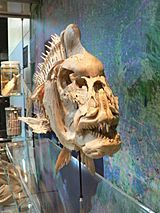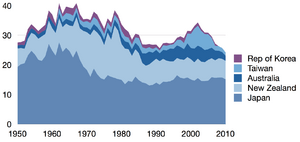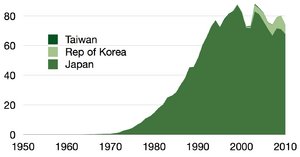Australasian snapper facts for kids
Quick facts for kids Australasian snapper |
|
|---|---|
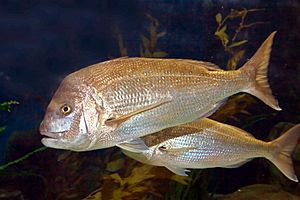 |
|
| Australasian snapper, Pagrus auratus, at Melbourne Aquarium. | |
| Conservation status | |
| Scientific classification | |
| Genus: |
Pagrus
|
| Species: |
auratus
|
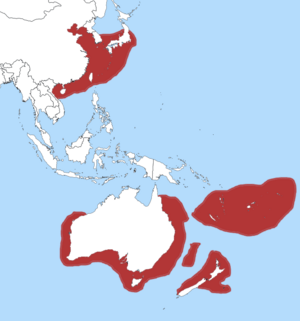 |
|
| Distribution of Australasian snapper | |
| Synonyms | |
|
Chrysophrys auratus (Forster, 1801) |
|
The Australasian snapper (Chrysophrys auratus) is a popular fish. It is also known as the silver seabream. You can find it in the coastal waters of countries like Australia, New Zealand, Japan, and China. Even though it's called "snapper" in Australia and New Zealand, it's actually a type of porgie fish, not a true snapper. People really enjoy eating this fish!
The scientific name for this species is Chrysophrys auratus. It was previously known as Pagrus auratus.
Contents
Different Names for the Snapper
The Australasian snapper has many different names. These names often depend on where the fish is caught or how big it is.
- Australia:
- Very young, smaller fish are called cocknies.
- Fish that are legal size are known as red bream or pinkies.
- When they get bigger, they are called squire or squirefish.
- Full-grown fish are simply called snapper.
- Western Australia: People often say "pink snapper" to tell it apart from other fish.
- Victoria: Sometimes people also call it schnapper.
- South Australia: Smaller legal-sized fish are often called "ruggers".
- Indigenous Australians: The Aboriginal people near Port Jackson called this fish wollamie. Early European settlers called it the "light horseman." This was because the fish's skull looked a bit like a soldier's helmet.
- New Zealand: It's usually just called snapper. If there's a need to be specific, it's "New Zealand snapper." In the Māori language, adult fish are tāmure, and young fish are karatī.
Where Snappers Live
The Australasian snapper lives all around New Zealand, especially in the northern areas. In Australia, you can find them along the southern coast. They are also found in Tasmania, but in smaller numbers.
These fish lay their eggs in waters close to shore. They live in rocky areas and on reefs, sometimes as deep as 200 meters. Snappers often swim together in groups. They also travel between different reefs. Larger fish can even swim into estuaries and harbors. For example, Port Phillip Bay is famous for its seasonal snapper run.
How Snappers Grow
How fast snappers grow can differ. Some, like those in New Zealand's Hauraki Gulf, grow quickly but don't get as big. Fish in east and west Australia grow more slowly. These fish can live for a long time, sometimes up to 40 years! The oldest known Australian snapper lived for 40 years and 10 months. It was a very large fish caught in Western Australia.
Snappers become able to have babies when they are about 30 cm long. A small number of male snappers will change into females when they reach puberty. Older male and female snappers can grow a noticeable hump on their heads.
Protecting Snappers
To help protect the fish population, anglers (people who fish) are asked not to catch fish that are too young. This helps make sure there are enough fish to breed. The legal size for catching snappers changes depending on the state in Australia. For example, in Queensland, fish must be at least 35 cm long. In Western Australia, they must be 50 cm long.
When snappers are breeding, their scales can get a shiny metallic green color. This color shows that acids are building up in their scales. Minimum sizes are set so that fish can breed at least once before they are caught. However, because these fish grow slowly, some people think we might need to close certain fishing areas. We might also need to make the minimum sizes even bigger. This would help prevent too many fish from being caught, especially with new fishing tools like GPS.
Snapper Fishing
Australasian snappers are caught for food. Between 2000 and 2009, the total amount of snappers caught each year was between 25,600 and 34,300 tonnes. Japan and New Zealand caught the largest amounts of these fish.



